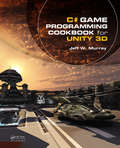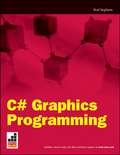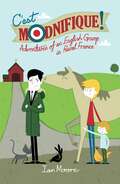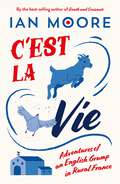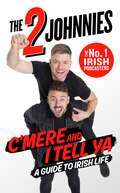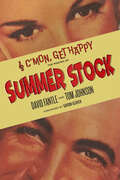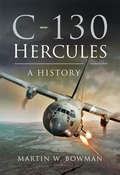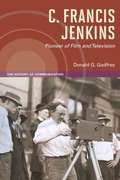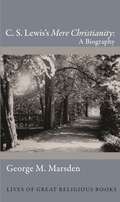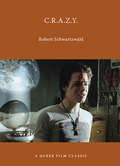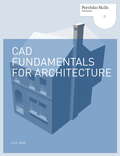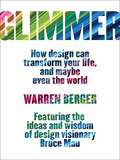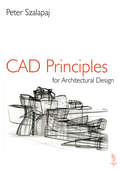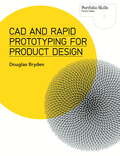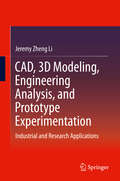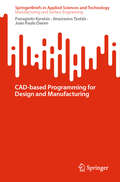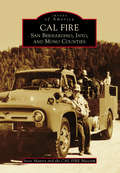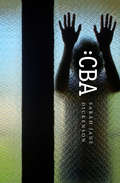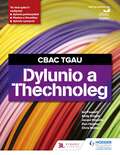- Table View
- List View
C# Game Programming Cookbook for Unity 3D
by Jeff W. MurrayAn Accessible, Modular Style of Game Building-Easily Start Making Games with Unity 3DC# Game Programming Cookbook for Unity 3D presents a highly flexible core framework to create just about any type of game by plugging in different script components. Most scripts function within the game framework or in your own structures. The techniques and conce
C# Graphics Programming
by Rod StephensThis Wrox Blox teaches you how to add graphics to C# 2008 applications, explaining fundamental graphics techniques such as: drawing shapes with different colors and line styles; filling areas with colors, gradients, and patterns; drawing text that is properly aligned, sized, and clipped exactly where you want it; manipulating images and saving results in bitmap, JPEG, and other types of files. Also covered are instructions for how to greatly increase your graphics capabilities using transformations. Transformations allow you to move, stretch, or rotate graphics. They also let you work in coordinate systems that make sense for your application. You will also learn how to use all of these techniques in printouts. The author describes the sequence of events that produce a printout and shows how to generate and preview printouts.The final sections describe two powerful new graphic tools that were introduced with .NET Framework 3.0: WPF graphics and FlowDocuments. WPF applications can use XAML graphic commands to declaratively draw and fill the same kinds of shapes that a program can draw by using graphics objects.Finally, a discussion on the FlowDocument object shows you how to define items that should be flowed across multiple pages as space permits. This lets you display text, graphics, controls, and other items that automatically flow across page breaks. FlowDocument viewers make displaying these documents easy for you, and simplifies the user's reading of the documents.This Wrox Blox also contains 35 example programs written in C# 2008, although most of the code works in previous versions of C# as well. The most notable exceptions are WPF graphics and FlowDocuments, both of which require WPF provided in .NET Framework 3.0 and later.
C'est Modnifique!: Adventures of an English Grump in Rural France
by Ian MooreAfter six years in the idyllic Loire Valley, comedian Ian Moore, his family and his growing menagerie feel like they’re on the cusp of the peace they hoped for. Their grand project, a writing school, is complete – only, nobody’s signed up. The Moores have their work cut out – but they’re determined to give it their best shot!
C'est Modnifique!: Adventures of an English Grump in Rural France
by Ian MooreAfter six years in the idyllic Loire Valley, comedian Ian Moore, his family and his growing menagerie feel like they’re on the cusp of the peace they hoped for. Their grand project, a writing school, is complete – only, nobody’s signed up. The Moores have their work cut out – but they’re determined to give it their best shot!
C'est la Vie: Adventures of an English Grump in Rural France
by Ian MooreFollow the misadventures of Ian Moore as he chronicles the charming and chaotic escapades of his family and their eccentric assembly of animals, on their continued search for serenity in rural France. With stresses, strains and animal poo mounting up, la famille Moore have their work cut out - but they're determined to give it their best shot!
C'mere and I Tell Ya: The 2 Johnnies Guide to Irish Life
by Johnny O'Brien Johnny McMahonThe 2 Johnnies' massive success has taken them as far afield as Sydney, Compton and Abu Dhabi. But for them nothing compares to living in Ireland. And in C'Mere and I Tell Ya they dig into the tastes, habits and rites of passage that have made them who they are.Whether it's ... - dressing for the debs ('I'd say my cravat was the talk of Templemore for weeks') - succeeding in a band ('I did backing vocals for six months and it turned out I was singing the wrong lyrics') - doing a Strictly fundraiser for your GAA club ('Remember you're not Julia Roberts and the local butcher isn't Richard Gere, so keep it in the pants') - recognizing the no-go moves at a stag ('Nobody wants to see a sixteen-stone man in a pink thong. Nobody')... Johnny B and Johnny Smacks capture it perfectly. And they have down-to-earth advice for every conceivable situation - and a few inconceivable ones.C'Mere and I Tell Ya is a one-stop celebration of Irishness, chicken goujons and being sound.'It's funny but there is always truth in the humour ... A hell of a Christmas present!' Oliver Callan, RTÉ
C'mon, Get Happy: The Making of Summer Stock
by Tom Johnson David FantleIn their third and final screen teaming, Judy Garland and Gene Kelly starred together in the MGM musical Summer Stock. Despite its riveting production history, charismatic lead actors, and classic musical moments, the movie has not received the same attention as other musicals from MGM’s storied dream factory. In C’mon, Get Happy: The Making of “Summer Stock,” authors David Fantle and Tom Johnson present a comprehensive study of this 1950 motion picture, from start to finish and after its release.The production coincided at a critical point in the careers of Kelly and an emotionally spent Garland. Kelly, who starred in An American in Paris just one year later, was at the peak of his abilities. On the other hand, Summer Stock was Garland’s final film at MGM, and she gamely completed it despite her own personal struggles. Summer Stock includes Kelly’s favorite solo dance routine and Garland’s signature number “Get Happy.”The authors discuss in rich detail the contributions of the cast (which included Gloria DeHaven, Eddie Bracken, Phil Silvers, and Marjorie Main); the director (Charles Walters); the producer (Joe Pasternak); the script writers (George Wells and Sy Gomberg); the songwriters (which included Harry Warren and Mack Gordon); and top MGM executives (Louis B. Mayer and Dore Schary). The volume features extensive interviews, conducted by the authors, with Kelly, Walters, Warren, and others, who shared their recollections of making the movie. Deeply researched, C’mon, Get Happy reveals the studio system at work during Hollywood’s Golden Era.Additionally, the authors have written a special section called “Taking Stock” that buttonholes numerous contemporary dancers, singers, choreographers, musicians, and even Garland impersonators for their take on Summer Stock, its stars, and any enduring legacy they think the film might have. Artists from Mikhail Baryshnikov, Ben Vereen, and Tommy Tune to Garland’s and Kelly’s daughters, Lorna Luft and Kerry Kelly Novick, respectively, offer their unique perspective on the film and its stars.
C-130 Hercules: A History
by Martin W. Bowman&“An engaging retrospective on the long-lived and ubiquitous C-130 Hercules tactical airlifter . . . Sweeping in its scope . . . an invaluable reference.&” —Aviation History Designed in response to a 1951 requirement, the C-130 Hercules is the most successful military airlifter ever built. Since it first flew in prototype form on August 23, 1954, more than 2,100 have been produced in over eighty different versions. Across its variants, the Hercules serves more than sixty air forces, as well as many civilian cargo operators, in a multiplicity of roles, including air-to-air refueller, gunship, airborne command post, flying hospital, and firefighter. This rugged and easily maintained aircraft entered service in 1956 with the USAF Tactical Air Command. Ten years later, the &“Charlie 130&” was providing essential logistical support in Vietnam. This period in Southeast Asia was the Hercules&’ finest hour. Paradrops, airlift, and evacuation operations were completed around the clock, often at low level, usually under fire and nearly always in bad weather. A generation later, this &“Mr. Dependable&” was serving with equal distinction in the Gulf War in the role of airlifter, radio-countermeasures, and &“psy-ops&” platform, gunship and, once again, &“block-buster bomber.&” The &“Herky Bird&” or &“Fat Albert,&” as the C-130 is fondly known, has proved a key component in humanitarian relief operations, as well, in all parts of the world. &“Martin&’s technical and informative look at their creation and use is absolutely fascinating. An iconic aircraft gets Martin&’s VIP treatment in this wonderful book.&” —Books Monthly &“A history of an aviation great, from the pen of a popular and well-established author of aviation history.&” —Firetrench
C. Francis Jenkins, Pioneer of Film and Television
by Donald G. GodfreyThis is the first biography of the important but long-forgotten American inventor Charles Francis Jenkins (1867-1934). Historian Donald G. Godfrey documents the life of Jenkins from his childhood in Indiana and early life in the West to his work as a prolific inventor whose productivity was cut short by an early death. Jenkins was an inventor who made a difference. As one of America's greatest independent inventors, Jenkins's passion was to meet the needs of his day and the future. In 1895 he produced the first film projector able to show a motion picture on a large screen, coincidentally igniting the first film boycott among his Quaker viewers when the film he screened showed a woman's ankle. Jenkins produced the first American television pictures in 1923, and developed the only fully operating broadcast television station in Washington, D.C. transmitting to ham operators from coast to coast as well as programming for his local audience. Godfrey's biography raises the profile of C. Francis Jenkins from his former place in the footnotes to his rightful position as a true pioneer of today's film and television. Along the way, it provides a window into the earliest days of both motion pictures and television as well as the now-vanished world of the independent inventor.
C. S. Lewis's Mere Christianity: A Biography (Lives of Great Religious Books #24)
by George M. MarsdenMere Christianity, C. S. Lewis's eloquent and winsome defense of the Christian faith, originated as a series of BBC radio talks broadcast during the dark days of World War Two. Here is the story of the extraordinary life and afterlife of this influential and much-beloved book. George Marsden describes how Lewis gradually went from being an atheist to a committed Anglican—famously converting to Christianity in 1931 after conversing into the night with his friends J. R. R. Tolkien and Hugh Dyson—and how Lewis delivered his wartime talks to a traumatized British nation in the midst of an all-out war for survival. Marsden recounts how versions of those talks were collected together in 1952 under the title Mere Christianity, and how the book went on to become one of the most widely read presentations of essential Christianity ever published, particularly among American evangelicals. He examines its role in the conversion experiences of such figures as Charles Colson, who read the book while facing arrest for his role in the Watergate scandal. Marsden explores its relationship with Lewis's Narnia books and other writings, and explains why Lewis's plainspoken case for Christianity continues to have its critics and ardent admirers to this day. With uncommon clarity and grace, Marsden provides invaluable new insights into this modern spiritual classic.
C.R.A.Z.Y.: A Queer Film Classic
by Robert SchwartzwaldA Queer Film Classic on the 2005 film debut by French-Canadian director Jean-Marc Vallée (best known for Dallas Buyers Club and Wild), about a young gay man who struggles to find his sense of self amidst a "crazy" family of four brothers and a homophobic father who seeks to cure him. The film won a best picture Genie Award (Canada's version of the Oscars) in 2006.Robert Schwartzwald in a professor at the Université de Montréal.
CABIN: Off the Grid Adventures with a Clueless Craftsman
by Patrick HutchisonTHE NATIONAL BESTSELLERA memoir of the author's journey from an office job to restoring a cabin in the Pacific Northwest, based on his wildly popular Outside Magazine piece.Wit’s End isn’t just a state of mind. It’s the name of a gravel road, the address of a run-down off-the-grid cabin, 120 shabby square feet of fixer-upper Patrick Hutchison purchased on a whim in the mossy woods of the Cascade Mountains in Washington state.To say Hutchison didn’t know what he was getting into is no more an exaggeration than to say he’s a man with nearly zero carpentry skills. Well, used to be. You can learn a lot over six years of renovations. CABIN is the story of those renovations, but it's also a love story; of a place, of possibilities, and of the process of construction, of seeing what could be instead of what is. It is a book for those who know what it’s like to bite off more than you can chew, or who desperately wish to.
CAD Fundamentals for Architecture
by Elys JohnComputer-aided design (CAD) is the dominant design and drawing tool used in architecture, and all students need to acquire basic skills in using it. This book explains the key CAD skills required to create plans, 3D models and perspectives. Detailed text and hundreds of screengrabs and visuals are used to demonstrate the various techniques and processes. 2D skills are shown using AutoCAD, SketchUp and Vectorworks, while 3D modelling and presentation techniques also include 3ds Max, Maya, Form·Z and Photoshop. The reader will learn how to simplify the software interface and tools in order to focus on the most common and useful tasks. This is an invaluable guide for all students of architecture.
CAD Fundamentals for Architecture (Portfolio Skills)
by Elys JohnComputer-aided design (CAD) is the dominant design and drawing tool used in architecture, and all students need to acquire basic skills in using it. This book explains the key CAD skills required to create plans, 3D models and perspectives. Detailed text and hundreds of screengrabs and visuals are used to demonstrate the various techniques and processes. 2D skills are shown using AutoCAD, SketchUp and Vectorworks, while 3D modelling and presentation techniques also include 3ds Max, Maya, Form·Z and Photoshop. The reader will learn how to simplify the software interface and tools in order to focus on the most common and useful tasks. This is an invaluable guide for all students of architecture.
CAD Monkeys, Dinosaur Babies, and T-Shaped People: Inside the World of Design Thinking and How It Can Spark Creativity and Innovation
by Warren BergerAn illuminating journey through today's fascinating world of design. What can we learn from the ways great designers think-and how can it improve our lives? In CAD Monkeys, Dinosaur Babies, and T-Shaped People Warren Berger, in collaboration with celebrated designer Bruce Mau, revolutionizes our understanding of design and unlocks the secrets of the trade. Looking to the creative problem-solving work of design professionals, Berger reveals that design is a mindset, a way of looking at the world with an eye toward improving it. The practice of design-thinking opens readers to their innate capacity for reimagining the world around them. .
CAD Principles for Architectural Design
by Peter SzalapajCAD Principles for Architectural Design is aimed at design students and practitioners interested in understanding how CAD is used in architectural practice. This book makes connections between the basic operations that are common to most CAD systems, and their use in practice on actual architectural design projects. The ways in which CAD is integrated into the design processes of several leading edge practices is illustrated. Arising from these case studies is the emergence of a contemporary phenomenon of integrated CAD, in which all aspects of design schemes are brought together within computational frameworks that support the analysis of design proposals.Szalapaj's view of CAD is one in which computers constitute a medium in which designers can express design ideas, rather than viewing computers as problem solving machines. For creative designers to successfully exploit CAD technology, CAD systems should reflect designers' intuitions as described by designers themselves
CAD and Rapid Prototyping for Product Design
by Douglas BrydenComputer-aided design (CAD) and rapid prototyping (RP) are now a fundamental part of the professional practice of product design and are therefore essential skills for product design undergraduate students. This book provides students with all the tools needed to get to grips with the range of both CAD software and RP processes used in the industry. Presented in a visually engaging format, this book is packed with case study examples from contemporary product designers, as well as screen shots, CAD models and images of rapid prototypes highlighting the design process. This book shows how CAD and RP software is used in product design and explains, in clear language, the similarities and differences between the different software packages and processes.
CAD and Rapid Prototyping for Product Design (Portfolio Skills)
by Douglas BrydenComputer-aided design (CAD) and rapid prototyping (RP) are now a fundamental part of the professional practice of product design and are therefore essential skills for product design undergraduate students. This book provides students with all the tools needed to get to grips with the range of both CAD software and RP processes used in the industry. Presented in a visually engaging format, this book is packed with case study examples from contemporary product designers, as well as screen shots, CAD models and images of rapid prototypes highlighting the design process. This book shows how CAD and RP software is used in product design and explains, in clear language, the similarities and differences between the different software packages and processes.
CAD, 3D Modeling, Engineering Analysis, and Prototype Experimentation: Industrial and Research Applications
by Jeremy Zheng LiThis succinct book focuses on computer aided design (CAD), 3-D modeling, and engineering analysis and the ways they can be applied effectively in research and industrial sectors including aerospace, defense, automotive, and consumer products. These efficient tools, deployed for R&D in the laboratory and the field, perform efficiently three-dimensional modeling of finished products, render complex geometrical product designs, facilitate structural analysis and optimal product design, produce graphic and engineering drawings, and generate production documentation. Written with an eye toward green energy installations and novel manufacturing facilities, this concise volume enables scientific researchers and engineering professionals to learn design techniques, control existing and complex issues, proficiently use CAD tools, visualize technical fundamentals, and gain analytic and technical skills. This book also: · Equips practitioners and researchers to handle powerful tools for engineering design and analysis using many detailed illustrations · Emphasizes important engineering design principles in introducing readers to a range of techniques · Includes tutorials providing readers with appropriate scaffolding to accelerate their learning process · Adopts a product development, cost-consideration perspective through the book's many examples
CAD-based Programming for Design and Manufacturing (SpringerBriefs in Applied Sciences and Technology)
by Panagiotis Kyratsis João Paulo Davim Anastasios TzotzisThis book offers a thorough examination of CAD-based programming in the context of design and manufacturing, structured across five key chapters. Readers will explore topics such as automated design, geometry feature recognition, and system assembly, as well as the generation of CNC codes directly from CAD models. The book delves into the integration of CAD with CAM and other modules, while addressing the opportunities and challenges posed by emerging technologies like AI and machine learning. Whether you are a designer, engineer, or simply interested in the field, this resource provides both practical insights and a forward-looking perspective on CAD-based workflows.
CAL FIRE: San Bernardino, Inyo, and Mono Counties (Images of America)
by Steve Maurer Cal Fire MuseumSince the establishment of the California State Board of Forestry in 1885, the mission of the California Division of Forestry has been to protect and preserve natural resources via a focus on resource management and protection of valuable watersheds. From the beginning, pioneers within the communities of San Bernardino County were actively involved in protecting their homes from the ravages of wildfire. In August 1930, San Bernardino County entered into a contract with the state to provide fire suppression and prevention on nonfederal lands within the county. The cooperative services agreement evolved to provide municipal fire protection services from both paid and volunteer staff. In addition to responsibilities within San Bernardino County, in the late 1980s the State Responsibility Area land within Inyo and Mono forestry units were consolidated under the San Bernardino, California Department of Forestry, Ranger Unit.
CBA
by Sarah Jane DickensonTrialled in schools with young people, CBA is a play that asks the really urgent questions of today. It seems so private, just you and the screen. You click 'send'. Then the whole world crashes through. Keisha has a secret, Georgia has a security problem and Tom is afraid to speak out. When should you tell someone's secret? How can jokes go so wrong? Fast paced and thought-provoking , CBA examines growing up in a digital world.
CBAC TGAU Dylunio a Thecnoleg (WJEC GCSE Design and Technology Welsh Language Edition)
by Chris Walker Ian Fawcett Dan Hughes Andy Knight Jennifer Tilley Jacqui HowellsWelsh-language editionReinforce classroom learning and boost students' understanding of their chosen area of design and technology with this textbook written for the WJEC GCSE Design & Technology specification for Wales.Written by leading D&T experts, this textbook will build your students' knowledge of the core principles, help to develop their designing and making skills and provide them with the opportunity to make sure they are ready to tackle both parts of the assessment.- Helps students clearly understand the core knowledge, understanding and skills and general concepts of designing and making, as well as build their knowledge, understanding and skills of either Engineering Design, Fashion and Textiles or Product Design in more depth.- Hones students' mathematical and scientific ability so they don't miss out on the easy marks.- Features practice questions in the style of the written exam to make sure students are confident to tackle the written element of the assessment.- Inspires and motivates students with stretch and challenge activities designed to challenge the more able learners and ensure progression to A-level.- Hones
CBAC TGAU Dylunio a Thecnoleg (WJEC GCSE Design and Technology Welsh Language Edition)
by Chris Walker Ian Fawcett Dan Hughes Andy Knight Jennifer Tilley Jacqui HowellsWelsh-language editionReinforce classroom learning and boost students' understanding of their chosen area of design and technology with this textbook written for the WJEC GCSE Design & Technology specification for Wales.Written by leading D&T experts, this textbook will build your students' knowledge of the core principles, help to develop their designing and making skills and provide them with the opportunity to make sure they are ready to tackle both parts of the assessment.- Helps students clearly understand the core knowledge, understanding and skills and general concepts of designing and making, as well as build their knowledge, understanding and skills of either Engineering Design, Fashion and Textiles or Product Design in more depth.- Hones students' mathematical and scientific ability so they don't miss out on the easy marks.- Features practice questions in the style of the written exam to make sure students are confident to tackle the written element of the assessment.- Inspires and motivates students with stretch and challenge activities designed to challenge the more able learners and ensure progression to A-level.- Hones
CDM 2015: A Practical Guide for Architects and Designers
by Paul BusseyThis is the designer’s essential guide to implementing the new CDM 2015 regulations. It provides both a straightforward overview of the key changes and new duty holders, including the Principal Designer, as well as full colour diagrams and annotated plans which demonstrate how to apply the principles in the real world. As the regulations come into force it aims to reassure those fearing a change in their obligations by outlining easy to use practical tools which will integrate the philosophy of the new regulations – of proportionate response, creative solutions and collaborative working – into day-to-day practice. It’s designed as a concise and handy quick reference guide, easy to carry around on site or use at your desk, translating what can be dry and often impenetrable legislation into a set of simple, intuitive, design friendly and safe messages.
